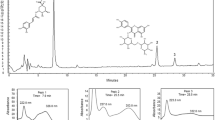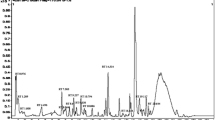Abstract
The fruits of Opuntia ficus-indica (L.) Mill. (OFI), a member of the family Cactaceae, are cultivated in Saudi Arabia and considered as a functional food with anti-inflammatory activity. The aim of current study was to chemically characterise OFI growing in Saudi Arabia by GC–MS and evaluate its anti-inflammatory activity in rat models via carrageenan-induced paw oedema and croton oil-induced ear oedema at two doses 100 and 200 mg/kg. Palmitic acid (10.68%), linoleic acid (5.9%), oleic acid (8.16%) and β-sitosterol (24.98%) are the major constituents in OFI seed oil. In carrageenan-induced rats, the OFI seed oil (100 and 200 mg/kg) produced significant inhibition of oedema by approximately 46% and 62%, respectively, and reduced prostaglandin (PGE2) concentrations in exudates by 54% and 67%, respectively. Also, it significantly decreased the weight of punch from challenged ears by 20% and 33% and myeloperoxidase (MPO) activity by 54% and 62% of the induced ear, respectively. This was accompanied by amelioration of croton oil-induced histopathological changes. In conclusion, the anti-inflammatory activity of the OFI seed oil might be attributed to the presence of unsaturated fatty acids (USFA) such as oleic acid (omega-9) in addition to β-sitosterol through decreasing PGE2 and MPO activity in the inflamed tissues which was supported by histopathological examination.




Similar content being viewed by others
References
Bjarnason, I.; Scarpignato, C.; Holmgren, E.; Olszewski, M.; Rainsford, K.D.; Lanas, A.: Mechanisms of damage to the gastrointestinal tract from nonsteroidal anti-inflammatory drugs. Gastroenterology 154(3), 500–514 (2018)
Deretic, V.; Klionsky, D.J.: Autophagy and Inflammation: A Special Review Issue. Taylor & Francis, Milton Park (2018)
Jones, R.; Rubin, G.; Berenbaum, F.; Scheiman, J.: Gastrointestinal and cardiovascular risks of nonsteroidal anti-inflammatory drugs. Am. J. Med. 121(6), 464–474 (2008)
Abdallah, H.; Abdel-Naim, A.; Ashour, O.; Shehata, I.; Abdel-Sattar, E.: Anti-inflammatory activity of selected plants from Saudi Arabia. Z. Naturforsch. C 69(1–2), 1–9 (2014)
Abdallah, H.M.; Almowallad, F.M.; Esmat, A.; Shehata, I.A.; Abdel-Sattar, E.A.: Anti-inflammatory activity of flavonoids from Chrozophora tinctoria. Phytochem. Lett. 13, 74–80 (2015)
Recio, M.; Andujar, I.; Rios, J.: Anti-inflammatory agents from plants: progress and potential. Curr. Med. Chem. 19(14), 2088–2103 (2012)
Shehata, I.A.; El-harshany, E.; Abdallah, H.M.; Esmat, A.; Abdel-Sattar, E.A.: Anti-inflammatory activity of Kleinia odora. Eur. J. Integr. Med. 23, 64–69 (2018)
Abdallah, H.M.; Esmat, A.: Antioxidant and anti-inflammatory activities of the major phenolics from Zygophyllum simplex L. J. Ethnopharmacol. 205, 51–56 (2017)
Calder, P.; Grimble, R.: Polyunsaturated fatty acids, inflammation and immunity. Eur. J. Clin. Nutr. 56(S3), S14 (2002)
Collenette, S.: Wildflowers of Saudi Arabia. National Commission for Wildlife Conservation and Development (NCWCD), Riyadh (1999)
Abdel-Hameed, E.S.S.; Nagaty, M.A.; Salman, M.S.; Bazaid, S.A.: Phytochemicals, nutritionals and antioxidant properties of two prickly pear cactus cultivars (Opuntia ficus indica Mill.) growing in Taif, KSA. Food Chem. 160, 31–38 (2014)
Park, E.-H.; Kahng, J.-H.; Lee, S.H.; Shin, K.-H.: An anti-inflammatory principle from cactus. Fitoterapia 72(3), 288–290 (2001)
Trejo-González, A.; Gabriel-Ortiz, G.; Puebla-Pérez, A.M.; Huízar-Contreras, M.D.; del Rosario Munguía-Mazariegos, M.; Mejía-Arreguín, S.; Calva, E.: A purified extract from prickly pear cactus (Opuntia fuliginosa) controls experimentally induced diabetes in rats. J. Ethnopharmacol. 55(1), 27–33 (1996)
Galati, E.; Tripodo, M.; Trovato, A.; Miceli, N.; Monforte, M.: Biological effect of Opuntia ficus indica (L.) Mill. (Cactaceae) waste matter: note I: diuretic activity. J. Ethnopharmacol. 79(1), 17–21 (2002)
Kaur, M.; Kaur, A.; Sharma, R.: Pharmacological actions of Opuntia ficus indica: a review. J. Appl. Pharm. Sci. 2(7), 15–18 (2012)
Park, E.-H.; Kahng, J.-H.; Paek, E.-A.: Studies on the pharmacological actions of cactus: identification of its anti-inflammatory effect. Arch. Pharm. Res. 21(1), 30–34 (1998)
González-Stuart, A.E.; Rivera, J.O.: Nutritional and Therapeutic applications of prickly pear cacti. Bioactive Food as Dietary Interventions for Diabetes, pp. 349–360. Elsevier, Amsterdam (2019)
Butera, D.; Tesoriere, L.; Di Gaudio, F.; Bongiorno, A.; Allegra, M.; Pintaudi, A.M.; Kohen, R.; Livrea, M.A.: Antioxidant activities of Sicilian prickly pear (Opuntia ficus indica) fruit extracts and reducing properties of its betalains: betanin and indicaxanthin. J. Agric. Food Chem. 50(23), 6895–6901 (2002)
Zito, P.; Sajeva, M.; Bruno, M.; Rosselli, S.; Maggio, A.; Senatore, F.: Essential oils composition of two Sicilian cultivars of Opuntia ficus-indica (L.) Mill. (Cactaceae) fruits (prickly pear). Nat. Prod. Res. 27(14), 1305–1314 (2013)
El Mannoubi, I.; Barrek, S.; Skanji, T.; Casabianca, H.; Zarrouk, H.: Characterization of Opuntia ficus indica seed oil from Tunisia. Chem. Nat. Compd. 45(5), 616 (2009)
Matthäus, B.; Özcan, M.M.: Habitat effects on yield, fatty acid composition and tocopherol contents of prickly pear (Opuntia ficus-indica L.) seed oils. Sci. Hortic. 131, 95–98 (2011)
Chougui, N.; Tamendjari, A.; Hamidj, W.; Hallal, S.; Barras, A.; Richard, T.; Larbat, R.: Oil composition and characterisation of phenolic compounds of Opuntia ficus-indica seeds. Food Chem. 139(1–4), 796–803 (2013)
Coşkuner, Y.N.; Tekin, A.: Monitoring of seed composition of prickly pear (Opuntia ficus-indica L.) fruits during maturation period. J. Sci. Food Agric. 83(8), 846–849 (2003)
Winter, C.A.; Risley, E.A.; Nuss, G.W.: Carrageenin-induced edema in hind paw of the rat as an assay for antiinflammatory drugs. Proc. Soc. Exp. Biol. Med. 111(3), 544–547 (1962)
Mnich, S.J.; Veenhuizen, A.W.; Monahan, J.B.; Sheehan, K.; Lynch, K.R.; Isakson, P.C.; Portanova, J.P.: Characterization of a monoclonal antibody that neutralizes the activity of prostaglandin E2. J. Immunol. Res. 155(9), 4437–4444 (1995)
Tonelli, G.; Thibault, L.; Ringler, I.: A bio-assay for the concomitant assessment of the antiphlogistic and thymolytic activities of topically applied corticoids. Endocrinology 77(4), 625–634 (1965)
Bradley, P.P.; Priebat, D.A.; Christensen, R.D.; Rothstein, G.: Measurement of cutaneous inflammation: estimation of neutrophil content with an enzyme marker. J. Invest. Dermatol. 78(3), 206–209 (1982)
Lowry, O.; Rosebrough, N.; Farr, A.; Randall, R.: Protein measurement with the Folin phenol reagent. J. Biol. Chem. 193(3), 265–275 (1951)
De Wit, M.; Hugo, A.; Shongwe, N.: Quality assessment of seed oil from selected cactus pear cultivars (Opuntia ficus-indica and Opuntia robusta). J. Food Process. Preserv. 41(3), e12898 (2017)
Sawaya, W.; Khan, P.: Chemical characterization of prickly pear seed oil, Opuntia ficus-indica. J. Food Sci. 47(6), 2060–2061 (1982)
Ciriminna, R.; Delisi, R.; Albanese, L.; Meneguzzo, F.; Pagliaro, M.: Opuntia ficus-indica seed oil: biorefinery and bioeconomy aspects. Eur. J. Lipid Sci. Technol. 119(8), 1700013 (2017)
Paniagua-Pérez, R.; Flores-Mondragón, G.; Reyes-Legorreta, C.; Herrera-López, B.; Cervantes-Hernández, I.; Madrigal-Santillán, O.; Morales-González, J.A.; Álvarez-González, I.; Madrigal-Bujaidar, E.: Evaluation of the anti-inflammatory capacity of beta-sitosterol in rodent assays. Afr. J. Tradit. Complement. Altern. Med. 14(1), 123–130 (2017)
Liz, R.; Zanatta, L.; dos Reis, G.O.; Horst, H.; Pizzolatti, M.G.; Silva, F.R.M.B.; Fröde, T.S.: Acute effect of β-sitosterol on calcium uptake mediates anti-inflammatory effect in murine activated neutrophils. J. Pharm. Pharmacol. 65(1), 115–122 (2013)
Acknowledgements
This project was funded by the Deanship of Scientific Research (DSR) at King Abdulaziz University, Jeddah, under grant no. (G-181-166-1440). The authors, therefore, acknowledge with thanks DSR for technical and financial support.
Author information
Authors and Affiliations
Corresponding author
Ethics declarations
Conflict of interest
The authors declare that they have no conflict of interest.
Rights and permissions
About this article
Cite this article
Koshak, A.E., Abdallah, H.M., Esmat, A. et al. Anti-inflammatory Activity and Chemical Characterisation of Opuntia ficus-indica Seed Oil Cultivated in Saudi Arabia. Arab J Sci Eng 45, 4571–4578 (2020). https://doi.org/10.1007/s13369-020-04555-x
Received:
Accepted:
Published:
Issue Date:
DOI: https://doi.org/10.1007/s13369-020-04555-x




